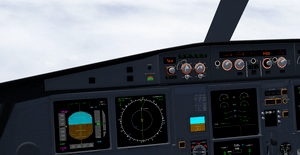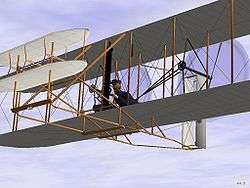FlightGear
 | |
 Cockpit View of A320neo in FlightGear 3.7 | |
| Original author(s) | David Murr, Curt Olson, Michael Basler, Eric Korpela[1] |
|---|---|
| Developer(s) | FlightGear Developers & Contributors |
| Initial release | July 17, 1997 |
| Stable release |
2018.2.2
/ June 3, 2018 |
| Repository |
|
| Written in | C++, C[2] |
| Operating system |
32-bit & 64-bit Windows Linux Mac OS X FreeBSD Solaris or IRIX |
| Platform | Cross-platform |
| Size | 1.54 GB (Main files) |
| Available in | English (Translations Available) |
| Type | Flight simulator |
| License | GNU General Public License |
| Website |
flightgear |
FlightGear Flight Simulator (often shortened to FlightGear or FGFS) is a free, open source multi-platform flight simulator developed by the FlightGear project since 1997.[3]
David Murr started the project on April 8, 1996. The project had its first release in 1997 and continued in development. It has specific builds for a variety of operating systems including Microsoft Windows, Mac OS X, Linux, IRIX, and Solaris.
FlightGear source code is released under the terms of the GNU General Public License and is free and open-source software.
Some commercial products—Earth Flight Sim, Flight Pro Sim, Flight Simulator Plus, Pro Flight Simulator, Real Flight Simulator, Virtual Pilot 3D, and others—are copies of old versions of FlightGear, see Commercial redistribution. They are not endorsed by the FlightGear project.[4]
History
FlightGear started as an online proposal in 1996 by David Murr. He proposed a new flight simulator developed by volunteers over the Internet as alternative to proprietary, available simulators like the Microsoft Flight Simulator. The flight simulator was created using custom 3D graphics code. Development of an OpenGL based version was spearheaded by Curtis Olson starting in 1997. FlightGear incorporated other open-source resources, including the LaRCsim flight model from NASA, and freely available elevation data. The first working binaries using OpenGL came out in 1997.
In June 2014 Honda lawyers issued a takedown request in which it was claimed that the HondaJet model in the simulator infringes on Honda's trademarks. Subsequently, HondaJet became the first model removed from the simulator due to legal reasons.[5]
Multiplayer
Several networking options allow FlightGear to communicate with other instances of FlightGear. A multiplayer protocol is available for using FlightGear on a local network in a multi aircraft environment. This can be used for formation flight or air traffic control simulation. Soon after the original Multiplayer Protocol became available, it was expanded to allow playing over the internet.
Several instances of FlightGear can be synchronized to allow for a multi-monitor environment.
Critical reception

Although not developed or typically analyzed solely as a game in the traditional sense, FlightGear has nevertheless undergone reviews in a number of online and offline publications, and received positive reviews as a flight simulator game.[6] FlightGear 1.0.0 was noted as being impressive for a game over a decade in the making, with a wide variety of aircraft and features.
PC Magazine noted how it is designed to be easy to add new aircraft and scenery.[7] Linux Format reviewed version 2.0 and rated it 8/10.[8]
Applications and usages
FlightGear has been used in a range of projects in academia and industry (including NASA) and even home-built cockpits.[9]
Commercial redistribution
FlightGear Flight Simulator version 1.9.1 has been actively marketed over the Internet by third parties under several aliases and product names, such as Earth Flight Sim, Flight Pro Sim, Flight Simulator Plus, Pro Flight Simulator, Real Flight Simulator, and Virtual Pilot 3D.[10]
Companies
- Aeronautical Development Agency, Bangalore, India.
- Veridian Engineering Division, Buffalo, NY.
- MathWorks FlightGear to Simulink interface.[11]
- NASA/Ames Human Centered System Lab - 737NG full scale cockpit simulator[12].[13]
- Pragolet s.r.o. for light and ultra-light sports aircraft.[14]
- ATC Flight Simulator Company, FAA approved flight simulator[15]
- ActiveFly paragliding simulator[16][17]
- Robert Heffley Engineering[18]
- PAL-V Europe NV[19]
- Max Planck Institute for Biological Cybernetics, Germany, HeliLab[20] and MPI CyberMotion Simulator[21]
- Institute for Scientific Research[22]
- Simuladores Guaraní, Argentina[23]
Endless Runway Project
Endless Runway Project, consortium of several European aerospace institutes.[24][25]
Universities
Africa
- Minia University, Egypt[26]
Asia
- The Department of Aircraft and Aeroengine from the Chinese Air Force Engineering University[27]
- Universiti Teknologi Malaysia[28]
- Nanjing University of Aeronautics and Astronautics, China[29]
- Indian Institute of Technology[30]
- Shenyang Institute of Automation, China[31]
Australia
- RMIT University, Melbourne, Australia[32]
Europe
- Institute of Aerospace Engineering at the RWTH Aachen[33]
- University of Naples, Italy[34]
- University of Wales Intelligent Robotics Group, Aberystwyth, UK[35]
- Delft University of Technology, the Netherlands[36][37][38][39]
- Hamburg University of Applied Sciences, Germany[40]
- Technical University of Munich[41]
- Czech Technical University in Prague[42][43]
- French Aerospace Lab (ONERA) and University of Toulouse, France[44]
- Pázmány Péter Catholic University and the Hungarian Academy of Sciences[45]
- University of Sheffield, England[46]
- Supaéro[47]
- Durham University, England[48]
North-America
- University of Illinois at Urbana Champaign, USA[49]
- Simon Fraser University, British Columbia Canada.
- Iowa State University, USA
- University of Minnesota, USA
- University of Tennessee, Chattanooga, USA[50]
- Department of Aerospace Engineering at The Pennsylvania State University, USA[51]
- Northeastern University, Boston, USA[52]
- Arizona State University, USA[53]
- University of Montreal, Canada and the University of Toulouse, France[54]
- The Center for Coastal & Ocean Mapping/Joint Hydrographic Center at the University of New Hampshire, USA[55]
- University of Michigan, USA[56]
- University of Toronto Institute for Aerospace Studies, Canada[57][58]
- Purdue University, Indiana, USA[59]
- University of Arizona, USA[60]
South-America
- Aeronautical Engineering University, Argentina[61]
- Universidade Federal de Minas Gerais, Brazil[62]
Home built applications
See also
References
- ↑ "FlightGear – Flight Simulator".
- ↑ "FlightGear source anylases". Ohloh.
- ↑ Barr, Joe (December 4, 2006). "FlightGear takes off". linux.com. Retrieved June 25, 2007.
- ↑ Flight Pro Sim, Flight Gear
- ↑ Ernesto (June 3, 2014). "Honda Takes Down "Infringing" Jet From FlightGear". TorrentFreak. Retrieved June 4, 2014.
- ↑ "Review". Flight Sim. Archived from the original on February 28, 2010.
- ↑ Smith, Tim (September 1, 2006). "FlightGear 0.9.10". PC Magazine (UK). Archived from the original on September 27, 2007. Retrieved June 29, 2007.
- ↑ Linux_Format_132_June_2010
- ↑ "Applications for the Simulator". usenix.org. Retrieved September 3, 2007.
- ↑ "FlightProSim statement". FlightGear. Retrieved December 4, 2010.
- ↑ <Aerospace Blockset
- ↑ LFS Technologies
- ↑ Human Centered System Labs, NASA
- ↑ Thöndel, Evžen (January 29, 2009). "Simulator of a Light and Ultra-Light Sport Aircraft". Pragolet.
- ↑ "ATC Flight Simulator".
- ↑ ActiveFly.com
- ↑ Video (YouTube)
- ↑ Heffley R.K. (August 2–5, 2010). "Use of a Task-Pilot-Vehicle (TPV) Model as a Tool for Flight Simulator Math Model Development". American Institute of Aeronautics and Astronautics. Retrieved August 16, 2012.
- ↑ "The PAL-V simulator".
- ↑ "HeliLab (Tiled Display)".
- ↑ "Der MPI-CyberMotion-Simulator".
- ↑ Eric F. Sorton, Sonny Hammaker (September 2005). "Simulated Flight Testing of an Autonomous Unmanned Aerial Vehicle Using FlightGear" (PDF).
- ↑ "Simuladores Guaraní".
- ↑ "Aircraft aspects of the Endless Runway" (PDF). September 30, 2013. Retrieved January 16, 2014.
- ↑ endlessrunway-project.eu
- ↑ "Automatic control education using FlightGear and MATLAB based virtual lab" (PDF). May 2012.
- ↑ XU Haojun, LIU Dongliang, XUE Yuan, ZHOU Li, MIN Guilong (January 12, 2012). "Airworthiness Compliance Verification Method Based on Simulation of Complex System" (PDF). Chinese Journal of Aeronautics.
- ↑ https://www.youtube.com/user/isfarazi
- ↑ "3D simulation of A-SMGCS surface movement based on FlightGear". May 16, 2012.
- ↑ Marianandam, Peter Arun; Ghose, Debasish (2014). "Vision Based Alignment to Runway During Approach for Landing of Fixed Wing UAVs".
- ↑ Chong Wu, Juntong Qi, Dalei Song, Jianda Han (May 24, 2013). "LP Based Path Planning for Autonomous Landing of An Unmanned Helicopter on A Moving Platform". Journal of Unmanned System Technology.
- ↑ Thorpe, Dylan (April 2007). "Modelling and Control of Tethered Kite Systems for Wind Energy Extraction" (PDF).
- ↑ http://www.dynamik.rwth-aachen.de/English/Simulators
- ↑ Domenico P. Coiro; Agostino De Marco; Fabrizio Nicolosi (2007). "A 6DOF Flight Simulation Environment for General Aviation Aircraft with Control Loading Reproduction" (PDF). Retrieved June 12, 2017.
- ↑ Aerobot Research, Dave Barne
- ↑ Ehlert, Patrick (January 18, 2005). "The Intelligent Cockpit Environment (ICE) Project". TU Delft.
- ↑ Ehlert P.A.M., Mouthaan Q.M., Rothkrantz L.J.M. (November 2002). "Recognising situations in a flight simulator environment" (PDF). SCS Publishing House. Retrieved April 18, 2012.
- ↑ Datcu Dragos (January 2003). "The ICE Project". Retrieved May 8, 2012.
- ↑ SIMONA
- ↑ Caja R., Scholz D. (November 23, 2012). "Box Wing Flight Dynamics in the Stage of Conceptual Aircraft Design" (PDF).
- ↑ "Mach mit ! - daedalus".
- ↑ at YouTube
- ↑ http://measure.feld.cvut.cz/en/cast
- ↑ (in French) Dehais, Frédéric (June 21, 2004). "Modélisation des conflits dans l'activité de pilotage" (PDF). University of Toulouse.
- ↑ "Collision avoidance for UAV using visual detection" (PDF).
- ↑ "Modelling and Autonomous Flight Simulation of a Small Unmanned Aerial Vehicle" (PDF). August 2006.
- ↑ "Aerodynamics MOOC using FlightGear". February 2015.
- ↑ Alan Purvis; Ben Morris; Richard McWilliam (2015). "FlightGear as a tool for real time fault-injection, detection and self-repair" (PDF). Durham Research Online.
- ↑ http://www.aae.uiuc.edu/sis/mainpapers.html
- ↑ Ellis, Dawn. "University of Tennessee at Chattanooga". FlightGear. Retrieved April 18, 2012.
- ↑ "A Multi-Disciplinary Rotorcraft Simulation Facility Composed of Commodity Components and Open Source Software" (PDF). Department of Aerospace Engineering, The Pennsylvania State University.
- ↑ "A brainy innovation takes flight". Northeastern University. May 31, 2011.
- ↑ Arizona State Tries Practice over Theory in Engineering Education, Campus Technology
- ↑ Latorre-Costa P., Defay F., Saussié D. (August 13–16, 2012). "Preliminary Study of an Active Feedback System for Aircraft Guidance". American Institute of Aeronautics and Astronautics. Retrieved August 16, 2012.
- ↑ "Spatially Aware Hand-held Devices and the Boat Simulator". Retrieved October 20, 2012.
- ↑ Duncan Miller (2011). "Autonomous Vehicle Laboratory for Sense and Avoid Research and Hardware-in-the-Loop Simulations" (pdf). American Institute of Aeronautics and Astronautics.
- ↑ Project Ornithopter (2006). "Flying the Ornithopter in FlightGear Flight Simulator" (html).
- ↑ "Human-powered ornithopter becomes first ever to achieve sustained flight". University of Toronto. September 22, 2010.
- ↑ "Cyber Attack Vulnerabilities Analysis for Unmanned Aerial Vehicles" (PDF).
- ↑ Umashankar, Rohit (April 30, 2013). "Thermal Energy Extraction Methods for UAV Gliders".
- ↑ http://gsdv.com.ar/fotos/20110528/index.html
- ↑ "Analise Comparativa Entre Microsoft Flight Simulator E Flightgear Flight Simulator Em Testes Hardware-In-The-Loop" (PDF).
- ↑ "TheViper".
- ↑ http://www.flightgear.org/Projects/747-JW/
External links
| Wikimedia Commons has media related to FlightGear. |
- Official website
- FlightGear on SourceForge.net
- About FlightProSim, Flight Simulator Plus, ProFlightSimulator and EarthFlightSim